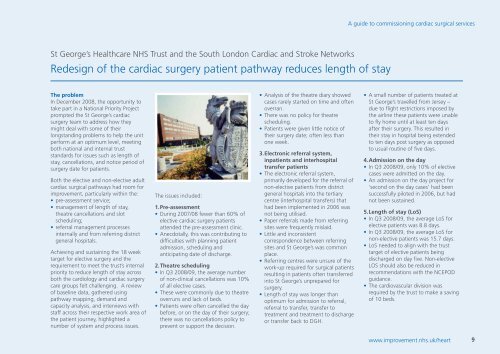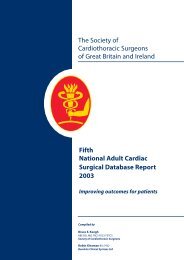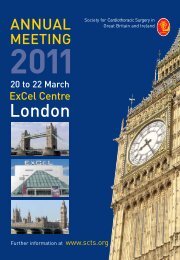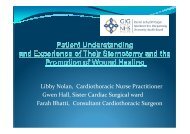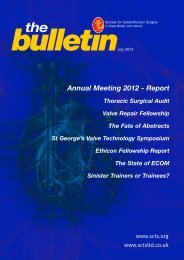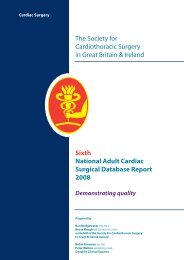A guide to commissioning cardiac surgical services - NHS ...
A guide to commissioning cardiac surgical services - NHS ...
A guide to commissioning cardiac surgical services - NHS ...
Create successful ePaper yourself
Turn your PDF publications into a flip-book with our unique Google optimized e-Paper software.
A <strong>guide</strong> <strong>to</strong> <strong>commissioning</strong> <strong>cardiac</strong> <strong>surgical</strong> <strong>services</strong><br />
St George’s Healthcare <strong>NHS</strong> Trust and the South London Cardiac and Stroke Networks<br />
Redesign of the <strong>cardiac</strong> surgery patient pathway reduces length of stay<br />
The problem<br />
In December 2008, the opportunity <strong>to</strong><br />
take part in a National Priority Project<br />
prompted the St George’s <strong>cardiac</strong><br />
surgery team <strong>to</strong> address how they<br />
might deal with some of their<br />
longstanding problems <strong>to</strong> help the unit<br />
perform at an optimum level, meeting<br />
both national and internal trust<br />
standards for issues such as length of<br />
stay, cancellations, and notice period of<br />
surgery date for patients.<br />
Both the elective and non-elective adult<br />
<strong>cardiac</strong> <strong>surgical</strong> pathways had room for<br />
improvement, particularly within the:<br />
• pre-assessment service;<br />
• management of length of stay,<br />
theatre cancellations and slot<br />
scheduling;<br />
• referral management processes<br />
internally and from referring district<br />
general hospitals.<br />
Achieving and sustaining the 18 week<br />
target for elective surgery and the<br />
requirement <strong>to</strong> meet the trust’s internal<br />
priority <strong>to</strong> reduce length of stay across<br />
both the cardiology and <strong>cardiac</strong> surgery<br />
care groups felt challenging. A review<br />
of baseline data, gathered using<br />
pathway mapping, demand and<br />
capacity analysis, and interviews with<br />
staff across their respective work area of<br />
the patient journey, highlighted a<br />
number of system and process issues.<br />
The issues included:<br />
1.Pre-assessment<br />
• During 2007/08 fewer than 60% of<br />
elective <strong>cardiac</strong> surgery patients<br />
attended the pre-assessment clinic.<br />
• Anecdotally, this was contributing <strong>to</strong><br />
difficulties with planning patient<br />
admission, scheduling and<br />
anticipating date of discharge.<br />
2.Theatre scheduling<br />
• In Q3 2008/09, the average number<br />
of non-clinical cancellations was 10%<br />
of all elective cases.<br />
• These were commonly due <strong>to</strong> theatre<br />
overruns and lack of beds.<br />
• Patients were often cancelled the day<br />
before, or on the day of their surgery;<br />
there was no cancellations policy <strong>to</strong><br />
prevent or support the decision.<br />
• Analysis of the theatre diary showed<br />
cases rarely started on time and often<br />
overran.<br />
• There was no policy for theatre<br />
scheduling.<br />
• Patients were given little notice of<br />
their surgery date; often less than<br />
one week.<br />
3.Electronic referral system,<br />
inpatients and interhospital<br />
transfer patients<br />
• The electronic referral system,<br />
primarily developed for the referral of<br />
non-elective patients from district<br />
general hospitals in<strong>to</strong> the tertiary<br />
centre (interhospital transfers) that<br />
had been implemented in 2006 was<br />
not being utilised.<br />
• Paper referrals made from referring<br />
sites were frequently mislaid.<br />
• Little and inconsistent<br />
correspondence between referring<br />
sites and St George’s was common<br />
place.<br />
• Referring centres were unsure of the<br />
work-up required for <strong>surgical</strong> patients<br />
resulting in patients often transferred<br />
in<strong>to</strong> St George’s unprepared for<br />
surgery.<br />
• Length of stay was longer than<br />
optimum for admission <strong>to</strong> referral,<br />
referral <strong>to</strong> transfer, transfer <strong>to</strong><br />
treatment and treatment <strong>to</strong> discharge<br />
or transfer back <strong>to</strong> DGH.<br />
• A small number of patients treated at<br />
St George’s travelled from Jersey –<br />
due <strong>to</strong> flight restrictions imposed by<br />
the airline these patients were unable<br />
<strong>to</strong> fly home until at least ten days<br />
after their surgery. This resulted in<br />
their stay in hospital being extended<br />
<strong>to</strong> ten days post surgery as opposed<br />
<strong>to</strong> usual routine of five days.<br />
4.Admission on the day<br />
• In Q3 2008/09, only 10% of elective<br />
cases were admitted on the day.<br />
• An admission on the day project for<br />
‘second on the day cases’ had been<br />
successfully piloted in 2006, but had<br />
not been sustained.<br />
5.Length of stay (LoS)<br />
• In Q3 2008/09, the average LoS for<br />
elective patients was 8.8 days.<br />
• In Q3 2008/09, the average LoS for<br />
non-elective patients was 15.7 days.<br />
• LoS needed <strong>to</strong> align with the trust<br />
target of elective patients being<br />
discharged on day five. Non-elective<br />
LOS should also be reduced in<br />
recommendations with the NCEPOD<br />
guidance.<br />
• The cardiovascular division was<br />
required by the trust <strong>to</strong> make a saving<br />
of 10 beds.<br />
www.improvement.nhs.uk/heart<br />
9


